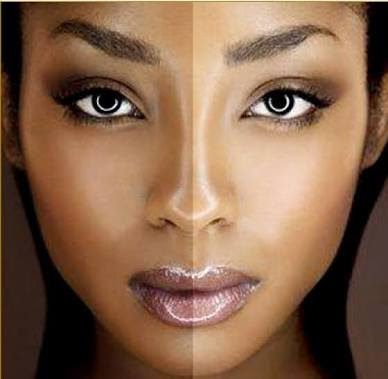NATURAL SKIN LIGHTENING ALTERNATIVES TO HYDROQUINONE
Melasma, the mask of pregnancy, or hyperpigmentation, dark patches of skin discoloration beyond freckles are caused by an increase in melanin production and can be a clear sign of sun damage. They tend to get darker during the sunny months, but without addressing them, they can stick around all year.
The most commonly used topical treatments for treating hyperpigmentation usually contain hydroquinone , a lightening agent–that while very effective at lightening dark spots by suppressing melanin production–is also highly toxic. It’s a carcinogen, immunotoxicant, neurotoxin and may also be an endocrine disruptor. It has also been linked to a skin condition called ochronosis, where the skin becomes dark and thick. It has been recommended that hydroquinone not be used in products that are left on the skin for extended periods of time. Therefore a lot of people turn to alternative whitening agents. In this article, BOLA AKINBOADE-BELLO presents to you natural alternatives to hydroquinone which you can use to treat dark spots.
AZELAIC ACID
Azelaic acid is a common alternative to hydroquinone and is a prescription-only acne treatment in many countries. It’s produced by a fungus, Pityrosporum ovale, which sometimes infects humans and causes light patches on the skin. It is slightly milder than hydroquinone, but in combination with retinoids has been as effective as 4% hydroquinone, with less side effects.
ARBUTIN
Arbutin is sometimes known as “natural hydroquinone” since its structure is very similar to that of hydroquinone. It’s found in extracts of bearberry leaves, and to a lesser extent in cranberry and blueberry leaves as well. Two synthetic forms of arbutin, alpha-arbutin and deoxyarbutin, are more potent than arbutin itself.
Though arbutin is a natural derivative of hydroquinone, it does not possess the same risks or side effects. Arbutin has been shown to be a very safe ingredient and does not break down into hydroquionone very readily.
Arbutin acts as a tyrosine mimic to slow down the production of melanin. It also interferes with the maturation of melanosomes, organelles responsible for melanin production.
KOJIC ACID
Kojic acid is a by-product in the fermentation process of malting rice for use in the manufacturing of sake, the Japanese rice wine.
Discovered in 1989, kojic acid is now used extensively as a natural alternative to hydroquinone. Kojic acid is derived from a fungus, and studies have shown that it is effective as a lightening agent, inhibiting production of melanin (brown pigment).
Kojic acid binds to copper in tyrosinase, preventing it from performing its role in the production of melanin.
LICORICE EXTRACT
An extract from the root of the licorice plant (Glycyrrhiza glabra) is popularly used as a whitening ingredient in cosmetics. It contains a number of antioxidant and anti-inflammatory chemicals, as well as the major whitening components, glabridin and liquirtin (and a range of other related flavonoids).
Glabridin inhibits pigmentation by preventing tyrosinase activation. Studies have shown that it can provide a considerable skin brightening effect while remaining non-toxic to the melanin forming cells.
NIACINAMIDE
Niacinamide also known as Vitamin B3 is an effective skin lightening compound that works by inhibiting melanomas transfer from melanocytes to keratinocytes. It has
soothing activity which may be useful for blemished skin. Can improve the appearance of aged, hyperpigmented and photodamaged skin. It also reduces the appearance of wrinkles and fine lines. When combined with vitamin A palmitate, niacinamide showed enhanced skin lightening properties.
MULBERRY EXTRACT
Mulberry root extract comes from the white Mulberry tree that is native to China, but cultivated in Europe, Japan, Australia and North America. The extract has been used for centuries in Chinese Medicine. Newer discoveries make it very useful in skin care.
Extracts of this root are potent inhibitors of Tyrosinase enzyme.
It has been found to lighten age spots and uneven skin tone;very nutritious for the hair and hair roots. It also has antioxidant and cleansing properties. Can be combined with other skin lighteners such as s licorice extract, kojic acid and arbutin.
VITAMIN C
Vitamin C is a natural antioxidant that occurs in many different forms (some stable and others unstable) each with distinct properties. Several of these forms have been shown to reduce melanin formation and provide a skin whitening effect when applied topically. These include l-ascorbic acid, magnesium ascorbyl phosphate and sodium ascorbyl phosphate. These forms when used individually or together can assist in slowing down hyperactive melanocytes and thus resulting in lighter skin.
Vitamin C is an ingredient in many skincare products, due to its potent antioxidant activity.
Ascorbic acid interacts with copper in tyrosinase, as well as disturbing other steps in melanin production.
- HOW TO DRESS LIKE PARISIAN WOMEN: ACHIEVING EFFORTLESS CHIC - August 14, 2024
- THE BRAVE ADVENTURE OF JOSH THE GREAT: A FAITH-FILLED JOURNEY OF COURAGE AND FORGIVENESS - August 14, 2024
- FASHION AND BEAUTY ICONS FROM AROUND THE WORLD - July 28, 2024




